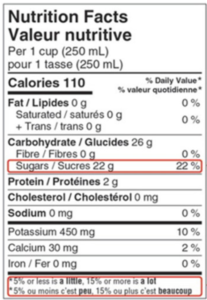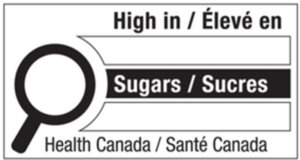- Start with Serving Sizes: Read the serving size on the Nutrition Facts Label. The serving size is the amount of the food product that the nutrition information is based on. You can use this information along with the total weight of the food package to determine how many servings are in the package.
- Scan the Nutrition Facts Table: to compare sugar contents and make healthier choices. The Percent Daily Value tells you if a food has a little (≤5% DV) or a lot (≥15% DV) of a nutrient. The percentage of each nutrient in a single serving is based on the daily recommended amount.
Let’s look at an example using the photo below! Here, 1 cup of the product (1 serving) has 22%DV. For nutrients, 5% DV or less is a little, and 15% DV or more is a lot, so choose foods with a lower % DV for sugars (5% DV or less) most often.

Photo from Health Canada https://www.canada.ca/en/health-canada/services/nutrients/sugars/using-food-labels.html
- Ingredients List: Identify sugars by their various names, such as high-fructose corn syrup, honey, and concentrated fruit juice. Sugar-based ingredients are found in brackets after the word sugars and are listed in descending order based on weight. In the photo, you can see that the Sugars are the first ingredient and make up most of the product, with fancy molasses as the major sugar based ingredient, present in the largest amount.
![]()
Photo from Health Canada https://www.canada.ca/en/health-canada/services/nutrients/sugars/using-food-labels.html
- LABEL ALERT! Check the Product Statement and Claims: You may have seen claims like “Low Sugar”, “No Added Sugar”, and “Reduced Sugar” on products, but what do they mean? See some examples below!
- Free of Sugars: A serving has under 0.5 grams of sugars. Claim examples: “Sugar-Free” or “Zero Sugar”
- Low in Sugars: A serving has 5 grams (g) of sugars or less. Claim examples: “Low Sugar” or “Little Sugar”
- No Added Sugars: A serving has no sugar or sugar-containing ingredients added. There may still be sugars in the food naturally. Claim examples: “No Sugar Added” or “Without Added Salt”
- Front of Pack Label: Look for the words “High in Sugars” on the front of pack label. This will show on packages when products have 15% or more of the Daily Value for sugars. Products will slowly be adding these labels until it is mandatory on January 1st of 2026, so keep your eyes peeled!

Photo from Health Canada https://www.canada.ca/en/health-canada/services/nutrients/sugars/using-food-labels.html
What about Low/No Calorie Sweeteners?
Low/No Calorie Sweeteners taste sweet but do not contain any sugar. They are found in products like diet drinks, sugar-free gum, sugar-free chocolate, desserts, sports drinks, yogurts, and more. Like added sugars, they have no nutritional benefits, but depending on the brand, may be low in calories or have no calories. While they can be used to decrease added sugars, sugar substitutes are not necessary for a healthy diet since products with sweeteners may not be healthy or low in calories, may replace healthier foods, and may lead to a preference for sweet foods since they still taste sweet.
Some common names for low or no calorie sweeteners include sorbitol, monk fruit, xylitol, mannitol, lacito, isomalt, erythritol, aspartame, saccharin, acesulfame potassium, sucralose, stevia, and more.
Like added sugars, read the ingredients list to identify these substitutes. Sweeteners can be listed under many names!
